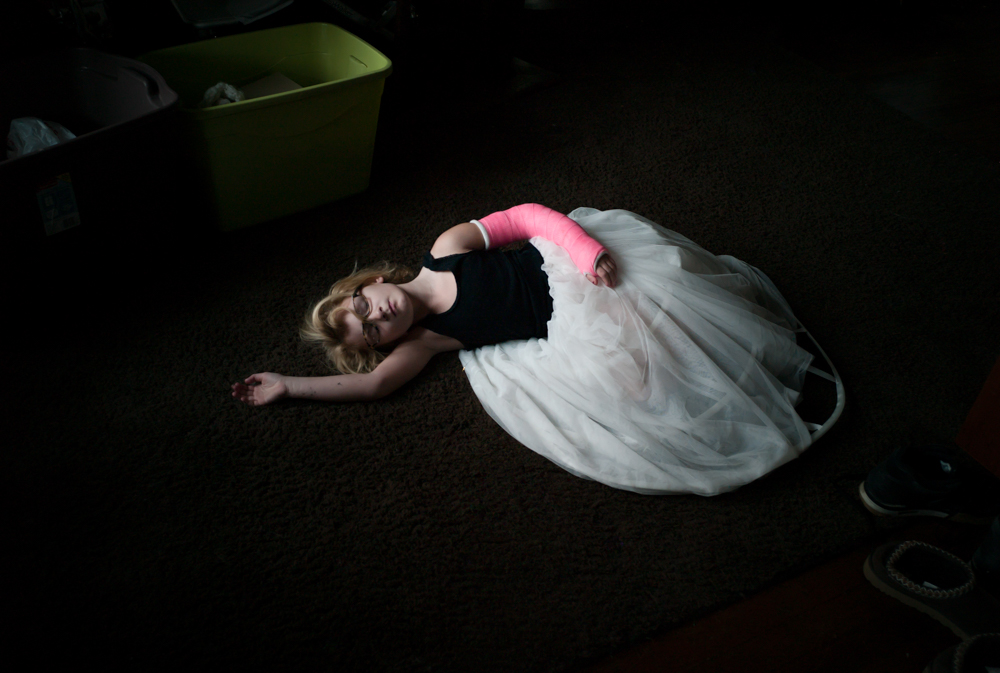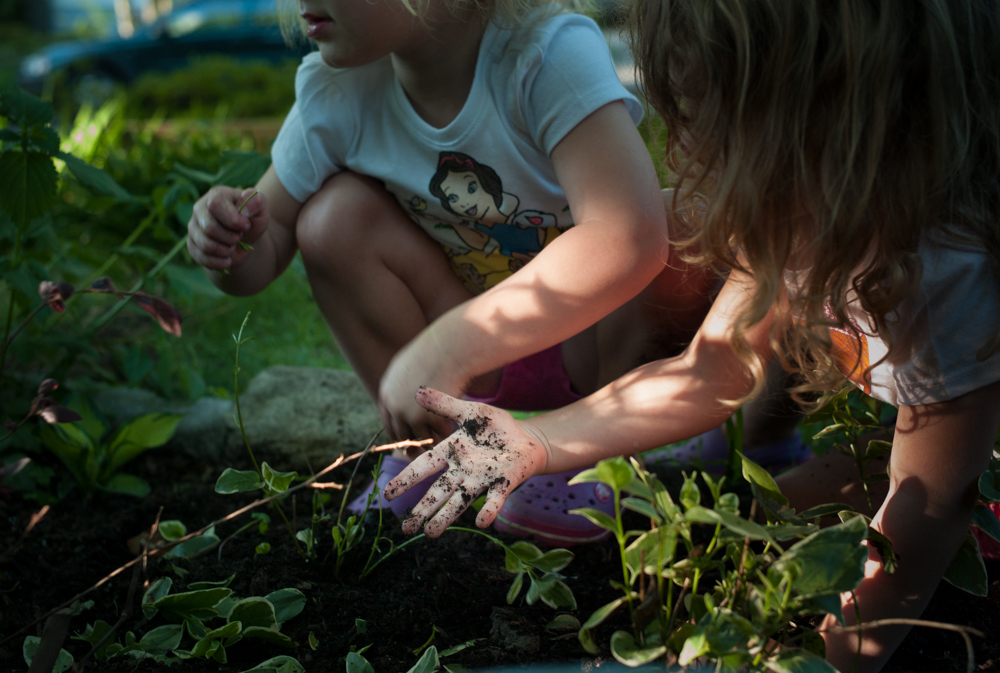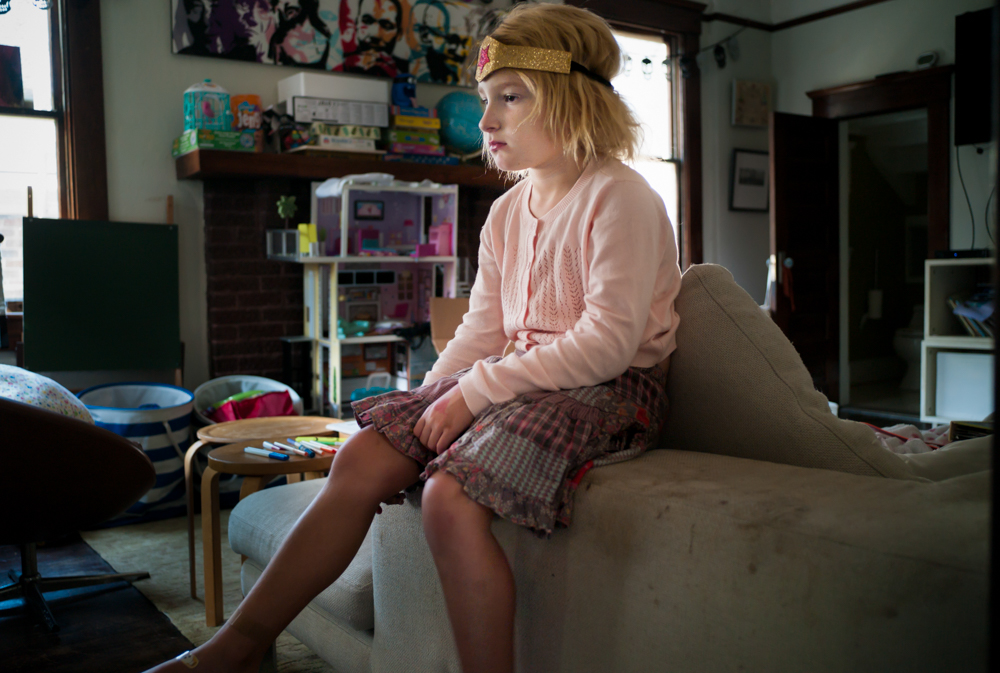Jaclyn Cori: Born on the Same Day
When asked to curate a week of posts leading up to Mother’s Day, I wanted to show artists whose work had not been shown before on Lenscratch. Because of my own endeavors and interest in family photographs, I chose artists whose work evolved from being a mother or a daughter.
Jaclyn Cori was introduced to me by Aline Smithson, who had met her at a workshop. It was a treat to explore her web site and see her photos of her twin daughters. And I found myself wishing I had made more photos of my son when he was young and didn’t mind. I guess we all have regrets for the photos we didn’t make.
Born on the Same Day
Born on the Same Day reflects the separation and interdependence of fraternal twin girls. By the taking on and discarding of roles, it is the discovery of their world through free play and fantasy. They embrace the life-long process of understanding themselves and each other, as I, their mother, the participant observer, balance seeing and being with them.
Every morning they open their eyes and there is “the other one”, their twin, their castmate. Everything around them began the same, yet they are entirely unique.
Snow White, draped in Rapunzel’s hair, cascades down the stairs. The twin, who refuses to wear clothes, sits on a stool examining a wounded knee. Snow White, donning a veil like Mother Teresa’s, twirls towards her cohort to get a glance. Her gesture, the transition of separateness to closeness is her own, but also an empathic gift to her sister, and a serendipitous moment for her mother photographer.
They weave a tale of drama, comedy, and tragedy. They dance together, push apart, run away and always return to dance together again. One moment they hate each other and the next they are giggling behind a closed bedroom door. Their story began with me soothing their booboos, providing costumes, and always being the safe haven. As princess costumes turned into gymnastics competitions and pointe shoes, simply kissed wounds have been replaced with the joys and sorrows of fantasy falling away. They cry, they scream, they triumph and fail, creating a space in a bigger world and turning to each other to be understood and accepted.
Sometimes I cry. Often, I laugh. I console. I advise. I listen. I feel their suffering and strength, working to lessen the former and develop the latter. And all the while I make photographs, having also become the archivist of their childhood, creating a lyrical, vivid family album as unique as each twin. –Jaclyn Cori
Jaclyn Cori (b. 1968) is a lens-based artist passionate for storytelling. Her work is narrative, based both on fact and fiction creating idiosyncratic and poetic imagery. Underlying themes reside in psychology of self.
Cori, a Professor of Photography at The Savannah College of Art and Design, is included in Who’s Who Among American Teachers and quoted in “Teaching Photography: Tools for the Imaging Educator”.
Her work has been exhibited in both solo and group exhibitions at venues including Cork Street Gallery in London, Cole Pratt Gallery in New Orleans, WithInSight Gallery in Chicago, Hagedorn Gallery in Atlanta, Photo Place Gallery and The Darkroom Gallery in Vermont.
Images from “Born on the Same Day” have been published in F-Stop Magazine, All About Photo, Art Ascent and Art Square New York. Cori is included in the books “The View Project” and “Eye Mama: Poetic Truths of Home and Motherhood”.
Follow Jaclyn Cori on Instagram @j_cori_norman and @professor_jaclyn
DD: I know from my experience that editing such personal family photographs can be a challenge. So, I’m curious about how you choose which images to show as your artwork?
JC: It’s exciting and it’s boring.
It’s a gut reaction. The light. The composition. The moment. That narrows 50,000+ images to about 500.
I only have time to really look at the work when the girls are in school, and I am not teaching. That leaves me about a month in the fall and another month in the winter. Each year I look at all the work slowly without judgement. Then I have a methodical rating system. I keep anything that is even possible. Then from those I keep the ones I like. It’s instinctual. I go through them again and keep the ones I really like. I keep doing this until I have between one and two hundred. Then I make small prints. I look at them daily, but don’t make decisions. Eventually I hold the stack in my hands, look at the top image and ask myself “Can I live without it?” This creates two piles. It must be an immediate decision. If I hesitate it goes in the “out” pile.
With the “in” pile I collect any images that are different versions of the same event. I edit down to what I think are the strongest without being redundant. Then every year I make a book. Every image must make my heart pound and have a purpose. Sometimes I look back through the “out” pile and see things I missed. Each year I look at all the previous books and add the new year’s prints, then edit down even more to make the newest book. I currently have nine books. The story keeps changing as we get older.
DD: Can you please tell us a little bit about how you work with your daughters to make the photographs?
JC: For just over a decade, I have been photographing my fraternal twin daughters. Previously I had always been a large format, B&W film photographer. I quickly found out that a tripod, dark cloth and darkroom could no longer be part of my photographic vision. I bought my first digital camera, a secondhand Leica M8. And now a secondhand Leica M.
I keep it on the mantle and watch for light and activity. In the beginning, I had neither intentions nor expectations. I just knew I needed to photograph. Now I understand that the camera allowed me to step outside of my overwhelmed self and “see” them grow. Since day one they have looked entirely different. What I didn’t know was that their inherent traits would diverge even more than their appearance. It’s that question of nature vs. nurture. In my own troubled upbringing, I persistently considered nurture to far supersede nature. Raising these two girls with the exact same everything around them has taught me to think differently.
I once expected this project to continue indefinitely, but as they approach being teens, they have become more self-conscious, self-aware and self-critical. I thought it was insecurity. What I am learning is that as their friends have accessed social media the audience has become their peers. Middle school kids are not always kind. I have been asked to stop taking pictures. This is hard. It is like a part of me is dying. But if I want to raise women who have the strength to create boundaries and the expectation that others will respect those boundaries, then I, their mother, must boldly support and acquiesce.
Deanna Dikeman has photographed her parents and relatives in Iowa and Nebraska for over 30 years. She was recently named a 2023 Guggenheim Fellow.
Instagram: @deannadikeman
Posts on Lenscratch may not be reproduced without the permission of the Lenscratch staff and the photographer.
Recommended
-
Shinichiro Nagasawa: The Bonin IslandersApril 2nd, 2024
-
The International Women in Photo Association Awards: Lorraine Turci: The Resilience of the CrowMarch 16th, 2024
-
The International Women in Photo Association Awards: Rayito Flores Pelcastre: Chirping of CricketsMarch 14th, 2024
-
The International Women in Photo Association Awards: Louise Amelie: What Does Migration Mean for those who Stay BehindMarch 12th, 2024
-
Brandon Tauszik: Fifteen VaultsMarch 3rd, 2024








































































